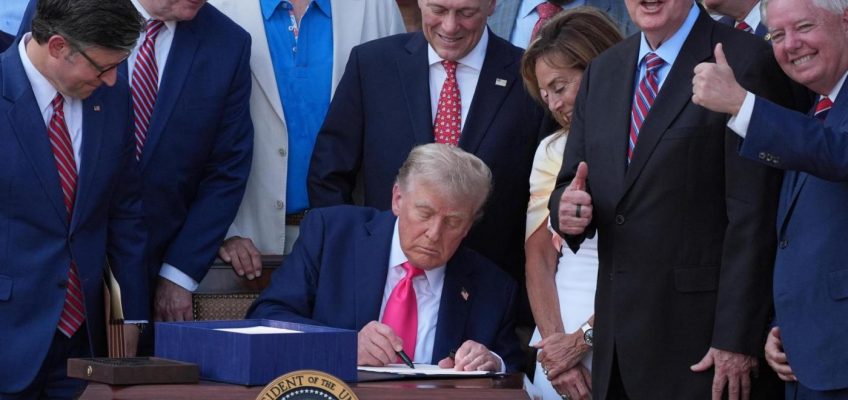While healthcare and social service providers, the solar and renewable energy industry and individual counties and municipalities are grappling with the many varied repercussions of the so-called “Big, Beautiful Bill,” some financial planners are applauding key aspects of the 800-page budget document recently signed into law by President Donald Trump.
Given how wide-ranging the legislation is, it may take a while for everyday tax filers — including seniors with significant retirement savings — to understand how the details impact them.
“A lot of people know some things are changing, but they don’t know what,” said Justin Halverson, a partner with Great Waters Financial in Shoreview, which specializes in retirement planning.
For “high earners, and even seniors that aren’t high earners, there’s good news there,” Halvorson said. “High earners, they’re getting the expanded tax brackets made permanent. They’re getting the state and local tax deductions.”
While projections vary, budget experts with the Committee for a Responsible Federal Budget have estimated the legislation will add $3 trillion to the national debt, at least $663 billion directly related to new tax cuts, the extended clean fuel tax credit, health savings account expansions, factory expensing and “Trump accounts” for kids.
Like Halvorson, Kristine Tidgren, director of Iowa State University’s Center for Agricultural Law and Taxation, has taken a deep dive into those and other tax changes.
Here’s a quick overview of what some of those tax savings are, from birth to estate hand-offs.
Trump accounts
Kids born between 2024 and 2028 are eligible to receive a $1,000 investment deposit from the U.S. Secretary of the Treasury. The goal is to encourage young people to save money. In addition, parents can put up to $5,000 per year in a tax-deferred diversified fund on behalf of their children under the age of 8, with the aim of watching the funds grow like an Individual Retirement Account, or an IRA for kids. Employers, nonprofits and government entities also can contribute, up to different limits.
The standard deduction
During the first Trump presidency, the Tax Cuts and Job Act of 2017 nearly doubled the standard deduction that individual filers could claim on their taxes, making itemized deductions less of a priority for many. The Big, Beautiful Bill makes permanent those standard deductions, as well as the 2017 ordinary income tax brackets, which is a relief to some in the financial planning industry who feared they would revert back as scheduled in 2026.
“If that went backwards, we had a lot of planning in place for if that were to happen,” Halvorson said.
Instead of being cut in half again, the standard deductions went up somewhat, growing from $15,000 to $15,750 for singles, and from $30,000 to $31,500 for married couples filing jointly.
Tips and overtime
The legislation creates temporary tax deductions through the year 2028 for up to $25,000 in qualified tips and up to $12,500 in overtime pay, both with income restrictions.
The SALT deduction
The State and Local Tax — known as SALT — deduction has long allowed taxpayers who itemize deductions to subtract certain state and local taxes, including property taxes, from their federal income before they calculate their tax liability. The SALT cap deduction, which was previously $10,000, has been temporarily raised to $40,000, with annual 1% increases scheduled through 2029.
“That’s going to primarily benefit higher-wage earners,” Halvorson said.
The senior deduction
Individual tax filers 65 or over can add up to $6,000 to their standard deduction through the year 2028, provided they’re not earning more than $75,000, or $150,000 for a married couple. That figure tapers out gradually for higher incomes, disappearing entirely for individuals earning more than $175,000 and couples earning more than $250,000.
That should be of special interest to seniors who have retired from the workplace but have yet to dip into their IRA or another retirement investment account.
“That’s a big one for seniors — a $6,000 senior deduction that can help reduce taxable income,” Halvorson said. “Either it’s going to lower their taxes, or it’s going to give them opportunities to do things that are strategic, like ROTH conversions or spend-downs.”
Estate tax exemption
As Baby Boomers and those of the Greatest Generation pass on, many are leaving a house — or two, or more — to their children and grandchildren. The greatest wealth transfer that the nation has ever seen is just over the horizon, and it just got easier to pass along those funds without paying hefty estate taxes. The Big, Beautiful Bill makes permanent, as of 2026, a $15 million-per-person estate tax exemption that was scheduled to revert to a lower amount. For couples, the exemption will be $30 million, indexed each year to inflation.
Health savings account expansions
The Big, Beautiful Bill expands the uses of health savings accounts in a handful of ways.
Employees enrolled in high-deductible health plans can waive the deductible and use their HSAs to cover the costs of telehealth without impacting their HSA eligibility, a benefit that the government allowed during the pandemic and then extended several times on a temporary basis. It’s now permanent, according to Stinson Law.
Eligibility for HSAs has expanded to employees who hold bronze-level or catastrophic care medical plans. Other changes allow HSAs to cover direct primary care services that charge a flat monthly fee. In addition, the annual limit for a dependent care flexible spending account (FSA) increases from $5,000 to $7,500 at the end of this year.
Related Articles
California Republican lawmakers launch campaign to require voter ID
Trump says he’s ‘highly unlikely’ to fire Fed’s Powell after floating that idea in private
Trump’s bid to claw back $9B in foreign aid and public broadcasting funds nears Senate vote
Stay or go? For some transgender sailors and Marines, Trump’s ban leaves one option: ‘Come and find me’
A look inside a lab making the advanced fuel to power growing US nuclear energy ambitions


Leave a Reply